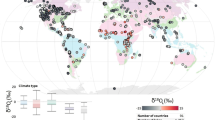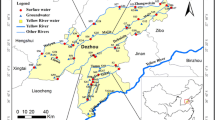Abstract
Stable isotope ratios of H and O are widely used to identify the source of water, e.g., in aquifers, river runoff, soils, plant xylem, and plant-based beverages. In situations where the sampled water is partially evaporated, its isotope values will have evolved along an evaporation line (EL) in δ2H/δ18O space, and back-correction along the EL to its intersection with a meteoric water line (MWL) has been used to estimate the source water’s isotope ratios. Here, we review the theory underlying isotopic estimation of source water for evaporated samples (iSWE). We note potential for bias from a commonly used regression-based approach for EL slope estimation and suggest that a model-based approach may be preferable if assumptions of the regression approach are not valid. We then introduce a mathematical framework that eliminates the need to explicitly estimate the EL–MWL intersection, simplifying iSWE analysis and facilitating more rigorous uncertainty estimation. We apply this approach to data from the US EPA's 2007 National Lakes Assessment. We find that data for most lakes are consistent with a water source similar to annual runoff, estimated from monthly precipitation and evaporation within the lake basin. Strong evidence for both summer- and winter-biased sources exists, however, with winter bias pervasive in most snow-prone regions. The new analytical framework should improve the rigor of iSWE in ecohydrology and related sciences, and our initial results from US lakes suggest that previous interpretations of lakes as unbiased isotope integrators may only be valid in certain climate regimes.










Similar content being viewed by others
References
Bijoor NS, McCarthy HR, Zhang D, Pataki DE (2012) Water sources of urban trees in the Los Angeles metropolitan area. Urban Ecosyst 15:195–214. https://doi.org/10.1007/s11252-011-0196-1
Bowen GJ (2008) Spatial analysis of the intra-annual variation of precipitation isotope ratios and its climatological corollaries. J Geophys Res 113:D05113. https://doi.org/10.1029/2007JD009295
Bowen GJ, Good SP (2015) Incorporating water isoscapes in hydrological and water resource investigations. Wiley Interdiscip Rev Water 2:107–119
Bowen GJ, Revenaugh J (2003) Interpolating the isotopic composition of modern meteoric precipitation. Water Resour Res 39:1299. https://doi.org/10.1029/2003WR002086
Bowen GJ, Wilkinson B (2002) Spatial distribution of δ18O in meteoric precipitation. Geology 30:315–318
Bowen GJ, Kennedy CD, Henne PD, Zhang T (2012) Footprint of recycled water subsidies downwind of Lake Michigan. Ecosphere 3(6):53. https://doi.org/10.1890/ES12-00062.1
Brooks JR, Barnard HR, Coulombe R, McDonnell JJ (2010) Ecohydrologic separation of water between trees and streams in a Mediterranean climate. Nat Geosci 3:100–104. https://doi.org/10.1038/NGEO722
Brooks JR, Gibson JJ, Birks SJ, Weber MH, Rodecap KD, Stoddard JL (2014) Stable isotope estimates of evaporation: inflow and water residence time for lakes across the United States as a tool for national lake water quality assessments. Limnol Oceanogr 59:2150–2165
Chesson LA, Bowen GJ, Ehleringer R (2010) Analysis of the hydrogen and oxygen stable isotope ratios of beverage waters without prior water extraction using isotope ratio infrared spectroscopy. Rapid Commun Mass Spectrom 24:3205–3213. https://doi.org/10.1002/rcm.4759
Clark I, Fritz P (1997) Environmental isotopes in hydrogeology. Lewis, Boca Raton
Corbin JD, Thomsen MA, Dawson TE, D’Antonio CM (2005) Summer water use by California coastal prairie grasses: fog, drought, and community composition. Oecologia 145:511–521. https://doi.org/10.1007/s00442-005-0152-y
Craig H (1961) Isotopic variations in meteoric waters. Science 133:1702–1703
Craig H, Gordon LI (1965) Deuterium and oxygen-18 variations in the ocean and the marine atmosphere. In: Tongiorgi E (ed) Proceedings of a conference on stable isotopes in oceanographic studies and paleotemperatures, Spoleto, Italy, vols 9–130
Dansgaard W (1964) Stable isotopes in precipitation. Tellus 16:436–468
Dawson TE (1998) Fog in the California redwood forest: ecosystem inputs and use by plants. Oecologia 117:476–485
Dawson TE, Ehleringer JR (1991) Streamside trees that do not use stream water. Nature 350:335–337
Dawson TE, Pate JS (1996) Seasonal water uptake and movement in root systems of Australian phraeatophytic plants of dimorphic root morphology: a stable isotope investigation. Oecologia 107:13–20. https://doi.org/10.1007/bf00582230
Ehleringer JR, Dawson TE (1992) Water uptake by plants: perspectives from stable isotope composition. Plant Cell Environ 15:1073–1082
Ehleringer JR, Phillips SL, Schuster WSF, Sandquist DR (1991) Differential utilization of summer rains by desert plants. Oecologia 88:430–434. https://doi.org/10.1007/bf00317589
Ehleringer JR, Barnette JE, Jameel Y, Tipple BJ, Bowen GJ (2016) Urban water—a new frontier in isotope hydrology. Isot Environ Health Stud 52:477–486. https://doi.org/10.1080/10256016.2016.1171217
Ellsworth PZ, Williams DG (2007) Hydrogen isotope fractionation during water uptake by woody xerophytes. Plant Soil 291:93–107. https://doi.org/10.1007/s11104-006-9177-1
Evaristo J, Jasechko S, McDonnell JJ (2015) Global separation of plant transpiration from groundwater and streamflow. Nature 525:91–94
Gat JR (1996) Oxygen and hydrogen isotopes in the hydrologic cycle. Annu Rev Earth Planet Sci 24:225–262
Gat JR, Bowser CJ (1991) The heavy isotope enrichment of water in coupled evaporative systems. In: Taylor HP, O’Neil JR, Kaplan IR (eds) Stable isotope geochemistry: a tribute to samuel epstein. The Geochemical Society, St. Louis, pp 159–168
Gibson JJ, Birks SJ, Edwards TWD (2008) Global prediction of δA and δ2H–δ18O evaporation slopes for lakes and soil water accounting for seasonality. Glob Biogeochem Cycles 22:GB2031. https://doi.org/10.1029/2007gb002997
Goldsmith GR, Muñoz-Villers LE, Holwerda F, McDonnell JJ, Asbjornsen H, Dawson TE (2012) Stable isotopes reveal linkages among ecohydrological processes in a seasonally dry tropical montane cloud forest. Ecohydrology 5:779–790
Good SP et al (2014) Patterns of local and non-local water resource use across the western United States determined via stable isotope intercomparisons. Water Resour Res. https://doi.org/10.1002/2014WR015884
Good SP, Noone D, Bowen GJ (2015a) Hydrologic connectivity constrains partitioning of global terrestrial water fluxes. Science 349:175–177. https://doi.org/10.1126/science.aaa5931
Good SP, Noone D, Kurita N, Benetti M, Bowen GJ (2015b) D/H isotope ratios in the global hydrologic cycle. Geophys Res Lett. https://doi.org/10.1002/2015GL064117
Henderson AK, Shuman BN (2009) Hydrogen and oxygen isotopic compositions of lake water in the western United States. Geol Soc Am Bull 121:1179–1189. https://doi.org/10.1130/B26441
Henderson AK, Shuman BN (2010) Differing controls on river- and lake-water hydrogen and oxygen isotopic values in the western United States. Hydrol Process 24:3894–3906
Horita J, Wesolowski DJ (1994) Liquid-vapor fractionation of oxygen and hydrogen isotopes of water from the freezing to the critical temperature. Geochim Cosmochim Acta 58:3425–3437
IAEA/WMO (2011) Global network of isotopes in precipitation. The GNIP Database. http://www.iaea.org/water. Accessed 11 Oct 2011
Jameel Y, Brewer S, Good SP, Tipple BJ, Ehleringer JR, Bowen GJ (2016) Tap water isotope ratios reflect urban water system structure and dynamics across a semiarid metropolitan area. Water Resour Res. https://doi.org/10.1002/2016WR019104
Jasechko S et al (2014) The pronounced seasonality of global groundwater recharge. Water Resour Res 50:8845–8867. https://doi.org/10.1002/2014WR015809
Kendall C, Coplen TB (2001) Distribution of oxygen-18 and deuterium in river waters across the United States. Hydrol Process 15:1363–1393
Kendall C, McDonnell JJ (eds) (1998) Isotope tracers in catchment hydrology. Elsevier, Amsterdam
Lin G, Sternberg L, Ehleringer J, Hall A, Farquhar G (1993) Hydrogen isotopic fractionation by plant roots during water uptake in coastal wetland plants. In: Ehleringer JR, Hall AE, Farquhar GD (eds) Stable isotopes and plant carbon–water relations. Academic Press, New York, pp 497–510
Mesinger F et al (2006) North american regional reanalysis. Bull Am Meteorol Soc 87:343–360. https://doi.org/10.1175/BAMS-87-3-343
Oerter EJ, Bowen G (2017) In situ monitoring of H and O stable isotopes in soil water reveals ecohydrologic dynamics in managed soil systems. Ecohydrology 10:e1841
Oerter E, Finstad K, Schaefer J, Goldsmith GR, Dawson T, Amundson R (2014) Oxygen isotope fractionation effects in soil water via interaction with cations (Mg, Ca, K, Na) adsorbed to phyllosilicate clay minerals. J Hydrol 515:1–9
Oerter E, Malone M, Putman A, Drits-Esser D, Stark L, Bowen G (2017) Every apple has a voice: using stable isotopes to teach about food sourcing and the water cycle. Hydrol Earth Syst Sci 21:3799–3810. https://doi.org/10.5194/hess-21-3799-2017
Roden JS, Ehleringer JR (2007) Summer precipitation influences the stable oxygen and carbon isotopic composition of tree-ring cellulose in Pinus ponderosa. Tree Physiol 27:491–501
Rozanski K, Araguas-Araguas L, Gonfiantini R (1993) Isotopic patterns in modern global precipitation. In: Swart PK, Lohmann KC, McKenzie J, Savin S (eds) Climate change in continental isotopic records. American Geophysical Union, Washington, DC, pp 1–36
R Core Team (2017) R: a language and environment for statistical computing. R Foundation for Statistical Computing, Vienna. https://www.R-project.org/. Accessed 7 Jan 2017
Tipple BJ et al (2017) Stable hydrogen and oxygen isotopes of tap water reveal structure of the San Francisco Bay Area’s water system and adjustments during a major drought. Water Res 119:212–224. https://doi.org/10.1016/j.watres.2017.04.022
Welhan JA, Fritz P (1977) Evaporation pan isotopic behavior as an index of isotopic evaporation conditions. Geochim Cosmochim Acta 41:682–686. https://doi.org/10.1016/0016-7037(77)90306-4
Welker JM (2000) Isotopic (δ18O) characteristics of weekly precipitation collected across the USA: an initial analysis with application to water source studies. Hydrol Process 14:1449–1464
Williams DG, Coltrain JB, Lott MJ, English NB, Ehleringer JR (2005) Oxygen isotopes in cellulose identify source water for archaeological maize in the American Southwest. J Archaeol Sci 32:931–939. https://doi.org/10.1016/j.jas.2005.01.008
Zhao L et al (2016) Significant difference in hydrogen isotope composition between xylem and tissue water in Populus euphratica. Plant Cell Environ 39:1848–1857
Acknowledgements
The authors are tremendously grateful for the inspiration, support, and mentorship of Jim Ehleringer, whose creativity and enthusiasm for science has impacted each of us and so many other young scientists worldwide. Support for this work was provided by U.S. National Science Foundation Grants EF-01241286 and DBI-1565128 to GJB. This manuscript has been subjected to Agency review and has been approved for publication. The views expressed in this paper are those of the author(s) and do not necessarily reflect the views or policies of the U.S. Environmental Protection Agency. Mention of trade names or commercial products does not constitute endorsement or recommendation for use.
Funding
Funding was provided by the U.S. National Science Foundation Directorate for Biological Sciences (EF-01241286 and DBI-1565128).
Author information
Authors and Affiliations
Contributions
GJB, DRB, EJO, and SPG conceived the study. GJB designed and performed the analyses. AP managed and prepared data. JRB provided data. GJB and JRB wrote the manuscript; other authors provided editorial advice.
Corresponding author
Ethics declarations
Conflict of interest
The authors declare no conflict of interest.
Additional information
Communicated by Todd E Dawson.
Rights and permissions
About this article
Cite this article
Bowen, G.J., Putman, A., Brooks, J.R. et al. Inferring the source of evaporated waters using stable H and O isotopes. Oecologia 187, 1025–1039 (2018). https://doi.org/10.1007/s00442-018-4192-5
Received:
Accepted:
Published:
Issue Date:
DOI: https://doi.org/10.1007/s00442-018-4192-5




